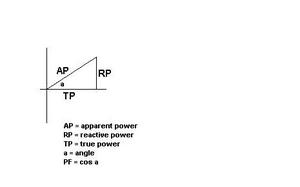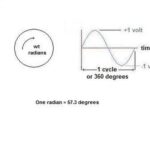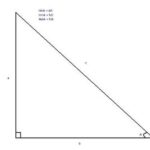REVIEW
AC electrical power consists of three types of power; apparent power, reactive power and true power. Apparent power, reactive power and true power form a right triangle. See Figure One.
True Power
True power is power dissipated by resistors.
TP = V * I * cos a
where
TP = true power
V = voltage
I = current
The angle “a” is the angle between the apparent power and the true power.
Reactive Power
Reactive power is power dissipated by inductors and capacitors.
RP = V * I * sine a
where
RP = reactive power
Apparent Power
Apparent power is measured in volt-amperes.
AP = V * I
where
AP = apparent power
According to the Pythagorean theorem
AP2 = RP2 + TP2
THE POWER FACTOR
The power factor is the cosine of the angle “a”. Another words, the power factor is equal to the true power divided by the apparent power.
cos a = true power/apparent power
Determining power factor in simple electrical circuits.
When the reactive power is zero, the apparent power equals the true power and the power factor is the cosine of zero degrees
cos 0o = 1
Therefore
PF = 1
where
PF = power factor
When the true power is zero, the power factor is the cosine of 90 degrees.
cos 90o = 0
Therefore
PF = 0
The power you pay for in your home is the apparent power. This means that you are paying for the reactive power of any inductors or capacitors in appliances in your home.
POWER FACTOR CORRECTION
Power factor correction involves the elimination of reactive power via creating a condition where the inductive reactance is equal to the capacitive reactance. The formula for the total impedance is:
Z = R + j(XL – Xc)
Where
Z = impedance
R = resistance
XL = inductive reactance
Xc = capacitive reactance
For a capacitor, voltage lags current by 90 degrees
Pc/-90o = V/-90o * I/0o
Where
Pc = power dissipated due to capacitance
For an inductor, voltage leads current by 90 degrees
Pi/90o = V/90o * I/0o
Where
Pi = power dissipated by inductance
The total reactive power RP is equal to the algebraic sum of the reactive power due to inductance and the reactive power due to capacitance
Rp = Pi + Pc
Rp = Pi/90o + Pc/-90o
If the value of Pi equals the value of Pc then the total reactive power RP is 0 watts. To understand why, see figure two. The two vectors Pi and Pc are in opposite directions and therefore the total reactive power is the algebraic difference between Pi and Pc.
If the inductive reactance XL equals the capacitive reactance Xc, then the total reactance is zero ohms. Hence the reactive power is zero watts. This means that the angle a is zero degrees. The power factor is the cosine of zero degrees.
cos a = cos 0o = 1
EXAMPLE
The electrical circuit shown in figure three has the following components:
Capacitor 1 * 10-2 farads
Inductor 1 henry
Resistor 100 ohms
The power source is 100 volts AC
The frequency is 1000 cycles per second
What is the power factor?
First we calculate the capacitive reactance
Xc = 1/(w*c)
where w = 2 * pi * freq
pi = 3.14
freq = frequency
c = capacitance
Xc = 1 divided by (2 * 3.14 * 10-2)
Xc = 1 divided by (6.28 * 10-2)
Xc = 102/6.28 = 15.92 ohms
Then we calculate the inductive reactance
XL = w*L
where
L = inductance
XL = 6.28 * 1 = 6.28 ohms
Then we calculate the total reactance
X = XL – Xc = 6.28 – 15.92 = -9.64
where
X = total reactance
The negative sign indicates that the reactive component of the total impedance is capacitive in nature.
Hence X = 9.64 ohms
Then we calculate the impedance
Z = R – jX = 100 – j9.64
According to the Pythagorean Theorem for triangles
Z2 = R2 + X2
Z2 = 1002 + 9.642
Z2 = 10000 + 92.93 = 10092.93
Z = 100.46 ohms
The tangent of the angle is equal to the reactance divided by the resistance.
arc tan 9.64/100 = .0964
arc tan .0964 = 5.5 degrees
So the total impedance is
100.46/5.5o
Then we calculate the current
I = V/Z = 100/(100.46/5.5o)
I = 0.995/-5.5o
Now we can calculate the apparent power
AP = I * V
AP = 0.995/-5.5o * 100 = 995/-5.5o
Now we can calculate the power factor
PF = cos 5.5o = 0.995
References:
I have a Bachelor of Science in Electrical Engineering
Introductory Circuit Analysis Third Edition
ISBN 0-675-8559-4






